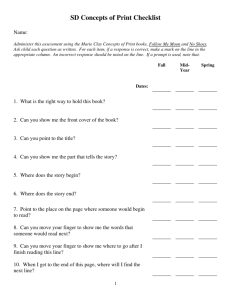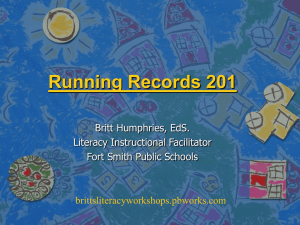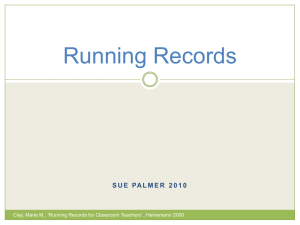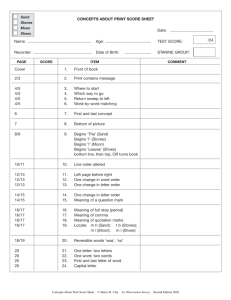Key Visuals & Quotes
advertisement
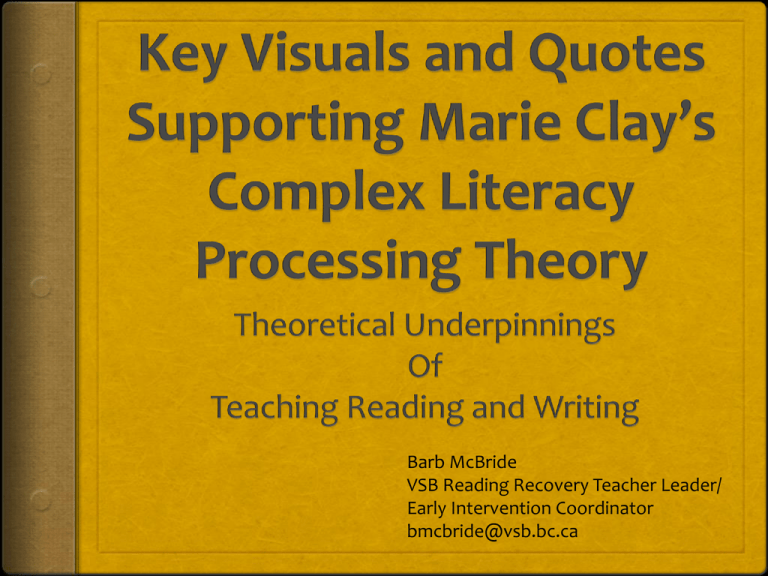
Barb McBride VSB Reading Recovery Teacher Leader/ Early Intervention Coordinator bmcbride@vsb.bc.ca The child cannot afford to waste time on letter-learning activities or games when he could be reading well-chosen books. Marie Clay, 2005 Literacy Lessons Designed for Individuals, Part 2 p121 Early Intervention / Intervention précoce Meeting the Needs of Every Grade 1 Child The child with stanines in the: 0 - 2 range is unlikely to ‘catch up’ without immediate, intensive expert teaching. 3 - 4 range is already struggling with average tasks. 4 - 6 range is able to participate in and benefit from average classroom activities. 7 - 9 range is probably eager to reach out to a more complex or challenging task. Clay, M.M. (2005) VSB Early Intervention / Reading Recovery Team SUPPORT TO INDEPENDENCE ZONE OF FRUSTRATION ZONE OF PROXIMAL DEVELOPMENT “LEARNING ZONE” (Vygotsky) The child is not yet able to learn task even with support or assistance. The child can do with support or assistance those things just beyond his level of development ZONE OF ACTUAL DEVELOPMENT The child can accomplish tasks (Piaget) independently Appropriate for guided practice, peer tutoring, or adult coaching Appropriate for independent learning Feeling of confidence and competence Text Level Accuracy 100-95% Feeling of uncertainty and questioning: state of challenge and growth 94-90% < 90% If she (a teacher) works alongside a child letting him do all that he can but supporting the activity when he reaches some limit by sharing the task she is more likely to uncover the cutting edges of his learning. He, on the other hand, will not be bored by doing ten times over something he already knows how to do, but is likely to be challenged to risk attempting the novel, knowing that help will be offered for shared completion of the task if he cannot do it alone. Marie Clay, 1991 Becoming Literate, p65-66 Gradual Release of Responsibility Teacher Responsibility Teacher and Student Responsibility Student Responsibility Shared Reading Explicit Demonstrations Shared Writing Independent Practice Sustained Reading Modeled Reading Modeled Writing Guided Reading Think Aloud Guided Writing Sustained Writing Teaching... can be likened to a conversation in which you listen to the speaker carefully before you reply. Marie Clay Comprehensive Literacy Program If we keep a note of the longest sentence we have heard him use, we can update it when a longer one comes along. Length of utterance is a reliable indicator of growth in early oral language skills. Marie Clay, 2005 Literacy Lessons Designed for Individuals, Part 2 p51 The teacher must make clear to the child that what he already knows in writing can be of use to him in reading and vice versa. Marie Clay, 2005 Literacy Lessons Designed for Individuals, Part 2 p121 Most people find it difficult to think of writing and reading as two different ways of learning about the same thing—written language. It is like having two hands. What you know in writing can be helpful in your reading and vice versa, just as the right hand can help the left hand with holding or vice versa. Marie Clay, 2002 Integration (of the sources of information) occurs in reading, in composing messages to be written, in writing, and in rereading a written message. Marie Clay, 2005 Literacy Lessons Designed for Individuals, Part 2 p88 I think it is most helpful to think of the learner (who is successfully solving reading problems) as building a neural network for working on written language and that network learns to extend itself. Marie Clay, 2005 Literacy Lessons Designed for Individuals, Part 1 p103 Processing System for Reading Fountas and Pinnell And in the end it is the individual adaptation made by the expert teacher to that child’s idiosyncratic competencies and history of past experiences that starts him on the upward climb to effective literacy performance. Marie Clay, 2005 Literacy Lessons Designed for Individuals, Part 1 p63
